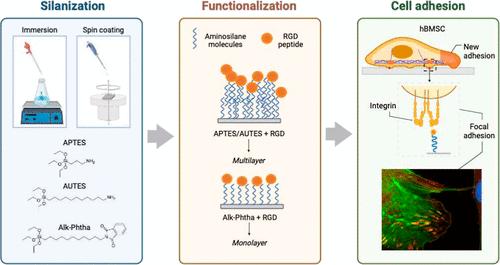当前位置:
X-MOL 学术
›
ACS Appl. Mater. Interfaces
›
论文详情
Our official English website, www.x-mol.net, welcomes your
feedback! (Note: you will need to create a separate account there.)
Silanization Strategies for Tailoring Peptide Functionalization on Silicon Surfaces: Implications for Enhancing Stem Cell Adhesion
ACS Applied Materials & Interfaces ( IF 8.3 ) Pub Date : 2024-06-04 , DOI: 10.1021/acsami.4c03727 Melissa Kosovari 1, 2, 3 , Thierry Buffeteau 4 , Laurent Thomas 4 , Andrée-Anne Guay Bégin 2, 3 , Luc Vellutini 4 , James D McGettrick 5 , Gaétan Laroche 2, 3 , Marie-Christine Durrieu 1
ACS Applied Materials & Interfaces ( IF 8.3 ) Pub Date : 2024-06-04 , DOI: 10.1021/acsami.4c03727 Melissa Kosovari 1, 2, 3 , Thierry Buffeteau 4 , Laurent Thomas 4 , Andrée-Anne Guay Bégin 2, 3 , Luc Vellutini 4 , James D McGettrick 5 , Gaétan Laroche 2, 3 , Marie-Christine Durrieu 1
Affiliation

|
Biomaterial surface engineering and the integration of cell-adhesive ligands are crucial in biological research and biotechnological applications. The interplay between cells and their microenvironment, influenced by chemical and physical cues, impacts cellular behavior. Surface modification of biomaterials profoundly affects cellular responses, especially at the cell–surface interface. This work focuses on enhancing cellular activities through material manipulation, emphasizing silanization for further functionalization with bioactive molecules such as RGD peptides to improve cell adhesion. The grafting of three distinct silanes onto silicon wafers using both spin coating and immersion methods was investigated. This study sheds light on the effects of different alkyl chain lengths and protecting groups on cellular behavior, providing valuable insights into optimizing silane-based self-assembled monolayers (SAMs) before peptide or protein grafting for the first time. Specifically, it challenges the common use of APTES molecules in this context. These findings advance our understanding of surface modification strategies, paving the way for tailoring biomaterial surfaces to modulate the cellular behavior for diverse biotechnological applications.
中文翻译:

在硅表面定制肽功能化的硅烷化策略:对增强干细胞粘附的影响
生物材料表面工程和细胞粘附配体的整合在生物研究和生物技术应用中至关重要。细胞与其微环境之间的相互作用受化学和物理因素的影响,影响细胞行为。生物材料的表面修饰深刻影响细胞反应,特别是在细胞表面界面。这项工作的重点是通过材料操作增强细胞活性,强调硅烷化以利用 RGD 肽等生物活性分子进一步功能化,以改善细胞粘附。研究了使用旋涂和浸渍方法将三种不同的硅烷接枝到硅片上。这项研究揭示了不同烷基链长度和保护基团对细胞行为的影响,为首次在肽或蛋白质接枝之前优化基于硅烷的自组装单层 (SAM) 提供了宝贵的见解。具体来说,它挑战了 APTES 分子在这种情况下的普遍使用。这些发现增进了我们对表面修饰策略的理解,为定制生物材料表面以调节不同生物技术应用的细胞行为铺平了道路。
更新日期:2024-06-04
中文翻译:

在硅表面定制肽功能化的硅烷化策略:对增强干细胞粘附的影响
生物材料表面工程和细胞粘附配体的整合在生物研究和生物技术应用中至关重要。细胞与其微环境之间的相互作用受化学和物理因素的影响,影响细胞行为。生物材料的表面修饰深刻影响细胞反应,特别是在细胞表面界面。这项工作的重点是通过材料操作增强细胞活性,强调硅烷化以利用 RGD 肽等生物活性分子进一步功能化,以改善细胞粘附。研究了使用旋涂和浸渍方法将三种不同的硅烷接枝到硅片上。这项研究揭示了不同烷基链长度和保护基团对细胞行为的影响,为首次在肽或蛋白质接枝之前优化基于硅烷的自组装单层 (SAM) 提供了宝贵的见解。具体来说,它挑战了 APTES 分子在这种情况下的普遍使用。这些发现增进了我们对表面修饰策略的理解,为定制生物材料表面以调节不同生物技术应用的细胞行为铺平了道路。


















































 京公网安备 11010802027423号
京公网安备 11010802027423号